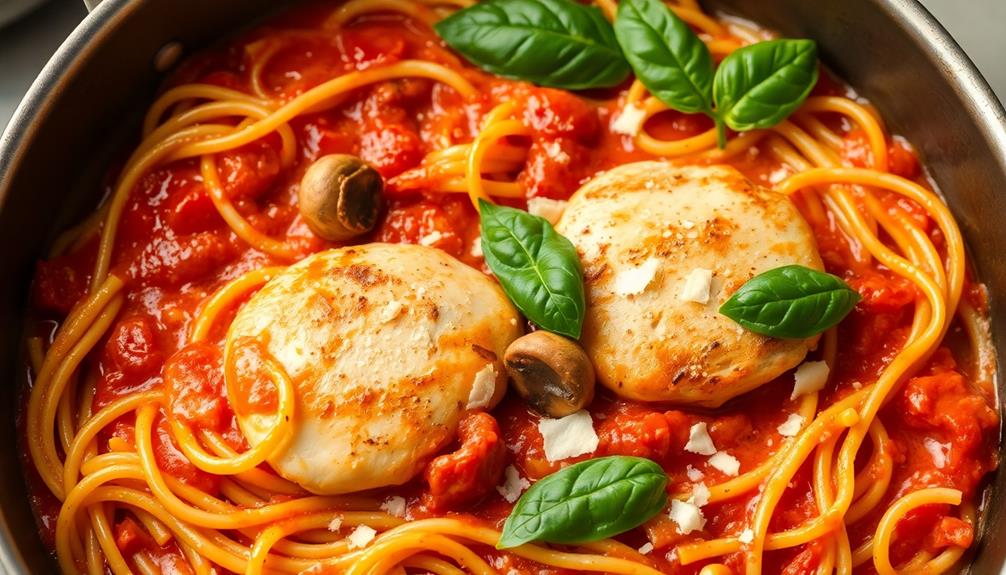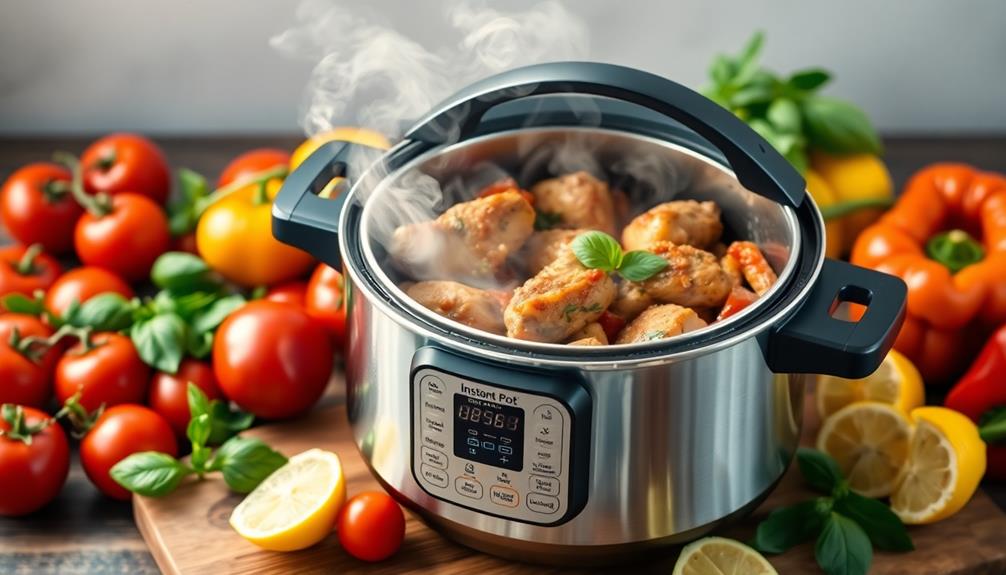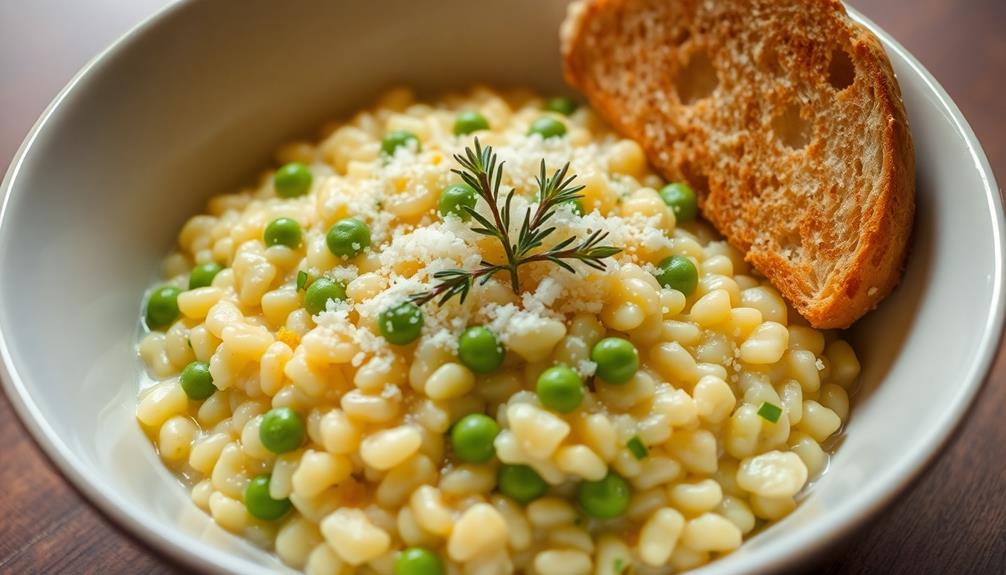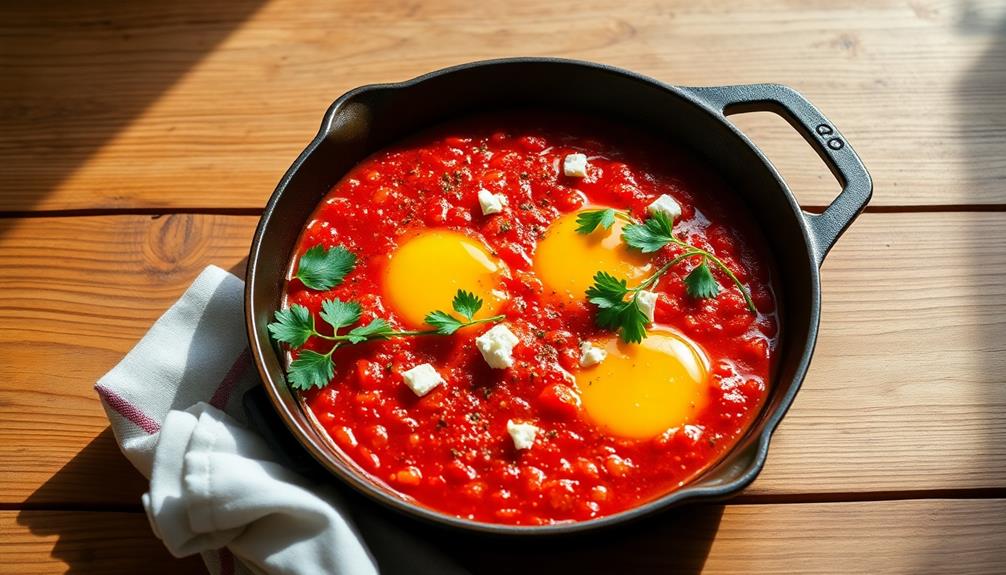One-pan pasta dishes bring the rich flavors of traditional Italian cuisine right to your kitchen, simplifying mealtime with their convenience and versatility. You'll love how quickly you can whip up a satisfying Italian-inspired dinner, using just a single pan! These all-in-one meals combine dried pasta, broth, tomatoes, garlic, and more – all simmered together until perfectly tender. The best part? You can customize the ingredients to suit your tastes, whether you prefer meat, seafood, or a vegetarian option. Discover how one-pan pasta can make dinnertime a breeze and inspire your culinary creativity. Let's dive deeper into the world of this Italian classic.
Key Takeaways
- One-pan pasta dishes have their roots in traditional Italian cooking, reflecting the Mediterranean culture's emphasis on simplicity and togetherness.
- These versatile recipes utilize core ingredients like dried pasta, broth, diced tomatoes, and greens, allowing for customization to suit individual preferences.
- The cooking process involves boiling the pasta, simmering it with seasonings and vegetables, and finishing with a creamy cheese topping for a satisfying meal.
- One-pan pasta dishes are convenient and practical, requiring minimal cleanup and offering a quick and easy solution for busy weeknights.
- These recipes encourage culinary creativity and the exploration of new flavor combinations, enabling home cooks to develop signature Italian-inspired dishes.
History
One-pan pasta dishes have been around for centuries, with roots tracing back to traditional Italian cooking. In the heart of the Mediterranean, families have been whipping up quick and easy pasta meals for generations. Back then, they didn't have fancy pots and pans – just a single pan on the stove. But that didn't stop them from creating delicious, saucy dishes that brought everyone together.
These one-pan wonders evolved over time as different regions and families put their own unique spin on the recipe. Some added fresh vegetables, while others experimented with bold herbs and spices. No matter the variation, the goal was always the same: to make a satisfying meal with minimal fuss. As the recipes evolved, home cooks discovered that organizing your kitchen for success was key to streamlining the process. By keeping essential ingredients and tools within easy reach, they could whip up these flavorful meals in no time. This not only made cooking more efficient but also allowed for more creative twists on the classic one-pan dishes.
Today, one-pan pasta dishes remain a beloved part of Italian cuisine. They're perfect for busy weeknights or relaxed weekend dinners. Plus, they're endlessly customizable, letting you unleash your inner chef.
Whether you're new to the one-pan lifestyle or a seasoned pro, these simple, flavorful dishes are sure to become a new family favorite.
Recipe
One-Pan Pasta Dishes: Recipe
Cooking pasta doesn't have to be a multi-step process. With a one-pan pasta dish, you can create a complete, flavorful meal in a single skillet. These types of dishes aren't only easy to prepare, but they also minimize cleanup, making them an excellent choice for busy weeknights.
One-pan pasta recipes typically combine uncooked pasta, broth or water, and a variety of ingredients like vegetables, proteins, and seasonings. The pasta cooks right in the pan, absorbing the flavors of the other components as it becomes tender.
- Dried pasta (such as penne, linguine, or spaghetti)
- Broth (chicken or vegetable) or water
- Diced tomatoes
- Onion, diced
- Garlic, minced
- Spinach or other greens
- Cooked chicken or shrimp
- Grated Parmesan cheese
- Olive oil
- Salt and pepper
In a large skillet or Dutch oven, combine the pasta, broth (or water), diced tomatoes, onion, and garlic. Bring the mixture to a boil over high heat, then reduce the heat to medium-low, cover, and simmer, stirring occasionally, until the pasta is tender and the liquid has been absorbed, about 15-20 minutes.
Stir in the spinach or greens and any cooked protein, and cook until the greens are wilted and the protein is heated through. Serve immediately, topped with Parmesan cheese.
When cooking one-pan pasta dishes, be sure to use a skillet or pot with high sides to prevent the liquid from bubbling over. Adjust the heat as needed to maintain a gentle simmer and avoid overcooking the pasta.
Experiment with different vegetable and protein combinations to create your own signature one-pan pasta dish.
Cooking Steps
First, bring a pot of water to a rolling boil.
Once it's bubbling, toss in the pasta and your favorite seasonings. Let it simmer until the noodles are tender, about 8 to 10 minutes.
Then, add your veggies and keep stirring until everything is heated through.
Step 1. Bring Water to a Boil
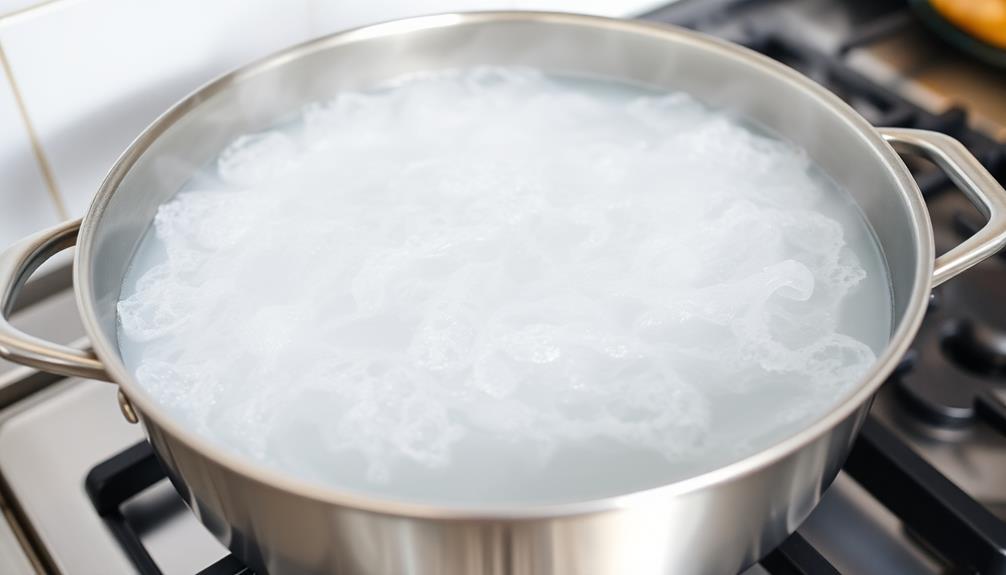
To begin, bring a large pot or skillet to a vigorous boil over high heat. This is a crucial first step in making your one-pan pasta dish.
You'll want to use a pot or skillet that's big enough to accommodate all the ingredients, including the pasta, sauce, and any other tasty add-ins.
Once the water is at a rolling boil, it's time to add your pasta. Carefully drop the noodles into the pot, making sure they're fully submerged.
Stir the pasta gently to prevent it from sticking together. Keep a close eye on the pot, adjusting the heat as needed to maintain that steady, bubbling boil. Cooking the pasta this way allows it to soak up all the flavorful juices, resulting in a one-pan meal that's bursting with taste.
As the pasta cooks, start preparing your sauce and other ingredients. With the water at a boil, you're well on your way to a delicious, hassle-free one-pan pasta dish.
Step 2. Add Pasta and Seasonings
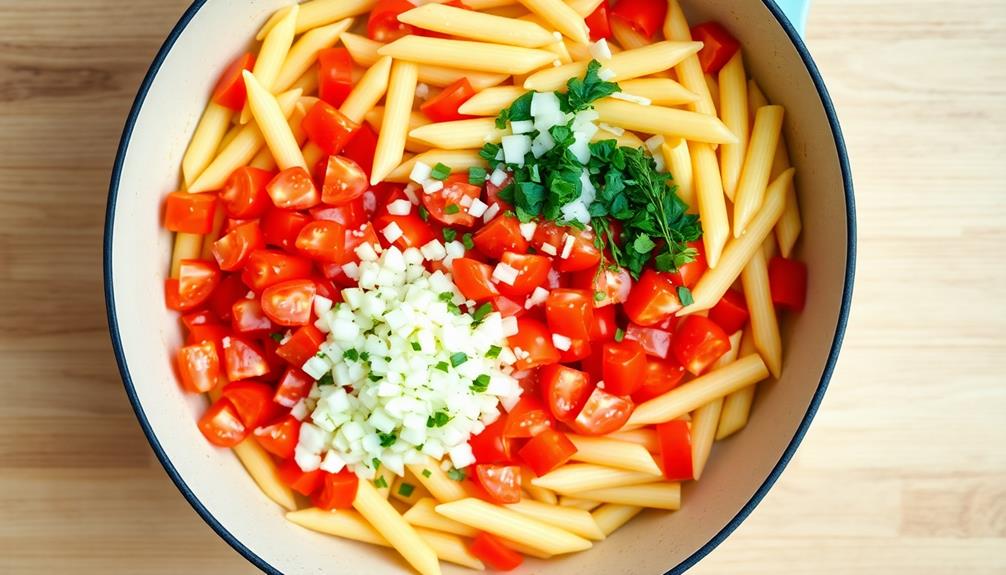
Once the water is boiling, carefully add the pasta to the pot, ensuring all the noodles are submerged.
Stir the pasta gently to prevent it from sticking together. Now it's time to add your seasonings! Sprinkle in some garlic powder, dried oregano, and a pinch of salt and pepper.
These simple seasonings will infuse your pasta with delicious flavor. Don't be afraid to get creative and experiment with different spice blends too. Maybe you'll want to add a dash of Italian seasoning or some crushed red pepper flakes for a little kick.
As the pasta cooks, keep an eye on it and give it a stir occasionally. You'll know it's done when it's tender but still has a slight bite to it, usually around 8-10 minutes.
Drain the pasta, reserving a bit of the cooking water, then return it to the pot. Now you're ready to toss in your favorite sauce and enjoy your one-pan pasta dish!
Step 3. Simmer Until Pasta Is Tender
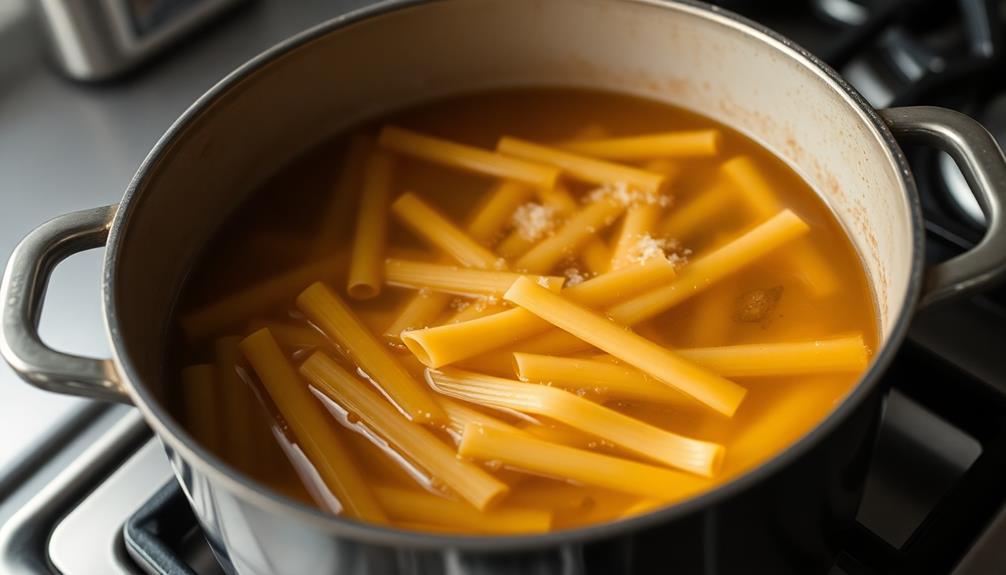
With the pasta now submerged, let it simmer away until tender, usually taking 8 to 10 minutes.
Gently stir the mixture occasionally to ensure the pasta cooks evenly. You'll know the pasta is done when it's soft and easy to bite through. The liquid should also have thickened into a delightful sauce.
If the pasta isn't quite tender yet, let it continue simmering for a minute or two longer, keeping a close eye on it.
Once the pasta reaches the perfect texture, remove the pan from the heat. The residual heat will continue to cook the pasta, so don't let it go too long.
Now you're ready to enjoy your one-pan pasta creation! Serve it up hot, garnished with fresh herbs or grated cheese, if desired.
This simple yet satisfying dish is sure to become a new family favorite.
Step 4. Add Vegetables
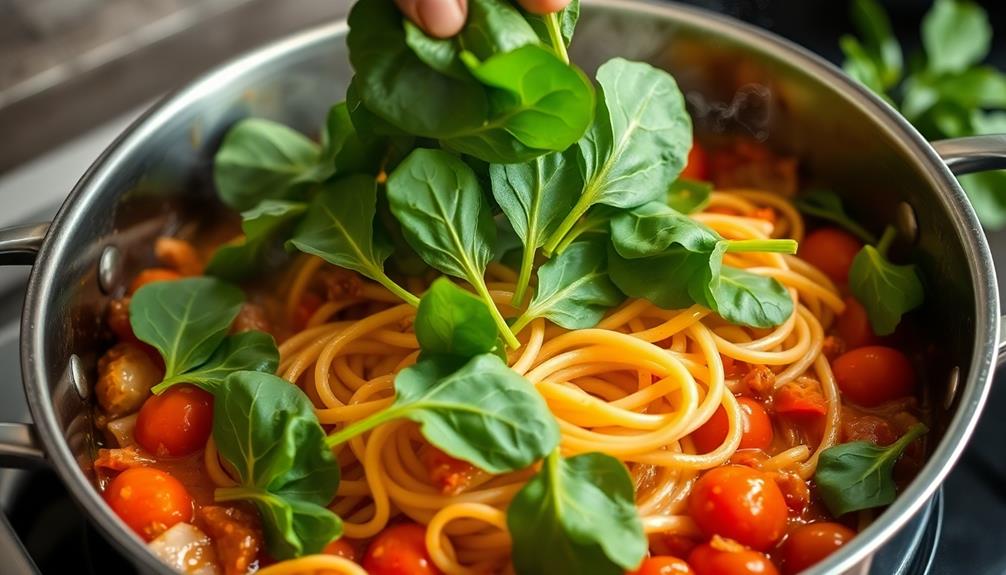
While the pasta simmers, turn your attention to the vegetables. This is your chance to add some color and crunch to your one-pan masterpiece.
Chop up your favorite veggies – maybe some bell peppers, zucchini, or cherry tomatoes. The key is to cut them into bite-sized pieces so they cook quickly and evenly.
If you're looking for inspiration, consider adding some fresh Daisy varieties for gardens to your dish for a pop of color. Toss the veggies right into the pan with the simmering pasta. They'll soak up all those delicious flavors as they steam and soften.
Don't be afraid to get creative! Try mixing in some spinach or mushrooms for extra nutrients. Just make sure to add them in the right order – the tougher veggies first, followed by the more delicate ones.
Keep an eye on it all, stirring occasionally, until the pasta is tender and the vegetables are perfectly cooked. Soon, you'll have a colorful, veggie-packed one-pan wonder ready to enjoy.
Step 5. Stir in Cheese and Garnish

Next, stir in a handful of shredded cheese. This melty addition will tie all the flavors together, creating a delightfully creamy one-pan pasta. Cheddar, mozzarella, or parmesan all work wonderfully, similar to how cheese enriches dishes like Cheesy Polenta.
Sprinkle the cheese over the hot pasta and gently fold it in until it's fully incorporated. The cheese will melt into the warm pasta, coating each bite.
Finally, garnish your creation with a few fresh herbs. Chopped basil, parsley, or even some thinly sliced green onions will add a burst of flavor and visual appeal. The herbs complement the pasta's rich, cheesy goodness, making each forkful a delightful experience.
With the cheese stirred in and the vibrant garnishes added, your one-pan pasta dish is ready to enjoy. The combination of creamy, melty cheese and fragrant herbs elevates this simple meal into something truly special.
Dig in and savor the satisfying flavors of your homemade Italian-inspired creation.
Final Thoughts
One-pan pasta dishes offer a convenient and delicious solution for busy weeknights. With minimal cleanup and endless flavor possibilities, these all-in-one meals are a game-changer in the kitchen. By combining your favorite pasta, sauce, and mix-ins in a single pan, you can have a satisfying Italian-inspired dinner on the table in no time.
The beauty of one-pan pasta dishes lies in their versatility. You can tailor the ingredients to suit your tastes, whether you prefer meat-based sauces, creamy alfredo, or vegetarian options. The key is to balance the flavors and textures, ensuring each bite is a perfect harmony of al dente pasta, savory sauce, and your choice of toppings.
As you explore the world of one-pan pasta dishes, don't be afraid to get creative. Experiment with different pasta shapes, sauces, and add-ins to find your signature recipes.
With a little practice, you'll be whipping up delicious, restaurant-quality meals right in your own kitchen. Embrace the convenience and enjoy the flavors of these one-pan wonders.
Frequently Asked Questions
How Long Do the Pasta Dishes Take to Prepare?
These one-pan pasta dishes don't take long at all – you can have a delicious Italian meal ready in under 30 minutes with minimal prep and cleanup. Just toss the ingredients in the pan and let the magic happen!
Can I Use Any Type of Pasta for These Recipes?
You can use any type of pasta for these one-pan recipes. From spaghetti to penne, the key is to choose a pasta that cooks quickly and pairs well with the other ingredients in the dish. The possibilities are endless!
Are the One-Pan Pasta Dishes Suitable for Vegetarians?
You'll be pleased to know that one-pan pasta dishes can be easily adapted for vegetarians. Simply swap out any meat-based ingredients for plant-based alternatives, and you'll have a delicious, meat-free meal that's perfect for your dietary needs.
Can I Make the Dishes Ahead of Time?
Absolutely! You can make one-pan pasta dishes ahead of time. Simply prepare the ingredients, cook the pasta, and assemble the dish. Then, you can store it in the fridge until you're ready to serve it up.
How Many Servings Does a One-Pan Pasta Dish Typically Yield?
A one-pan pasta dish typically yields 4-6 servings, depending on the recipe and the size of your pan. The exact serving size can vary, so be sure to check the recipe instructions for the recommended number of portions.
